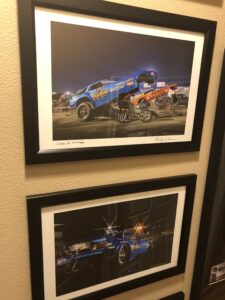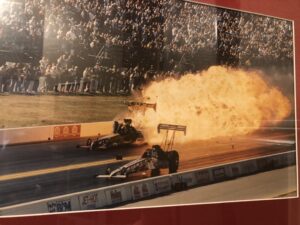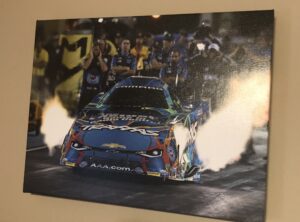Hey everyone. BW here. I just got home on this Thursday afternoon from my appointment to receive Pfizer vaccine shot #2. Had to drive back up to Fridley to get it, but the process was even smoother than it was for the first shot. Way more people getting the second one, so that eliminates one whole layer of paperwork. You just show up with your card and get poked.
Barbara is four days ahead of me in the process. When she got her second shot on Sunday, she was pretty much fine for 24 hours (other than soreness in her arm) but right at the 24-hour mark she started to feel all the after-effects. It only lasted a day, but she was pretty miserable. We’ll see how it goes for me.
The blog below, again submitted by Elon Werner who has really taken partial ownership of this endeavor while I finish my new book, is a great one about a group of professional people who bring the sport of drag racing to millions of eyeballs all year long. They are the professional photographers who cover the sport, either working as contracted free-lancers who shoot for paying clients or as staff members for various publications and websites, including National Dragster and NHRA.com. They are phenomenally dedicated and equally talented.
I’ve had great relationships with many of the “shooters” he mentions, and have hired a few for specific jobs. Mark Rebilas is a world-class photographer who shoots Super Bowls, World Cups, and Olympics for major publications. We’re all fortunate that he loves NHRA Drag Racing enough to cover our sport as well. And he’s a great guy. I hired him to shoot front and back cover photos for my book “Bats, Balls, & Burnouts” because I knew he’d understand my vision for it and do something really creative. He delivered. Richard Shute was shooting photos on the NHRA tour before I ever got in the sport, and is still out there. He contributed some photos for my book as well. They were photos from the weekend we swept the Skoal Showdown and the Mac Tools US National in 2005, and I had bought them as prints back then. I worked out an arrangement with Richard to use them in the book.
And that brings up a key point Elon mentions in this blog. The photographers who cover our favorite sport aren’t doing it for fun. It may actually be fun, but they are working and making a living. They’ve invested heavily to get where they are. They need to get paid. Far too many racers or fans don’t get that. Those photos belong to the photographer. You can pay to get them, but they’re not free.
As a fun side note, when Mark Rebilas is shooting a major event, like a Super Bowl, we often play “Spot Rebilas” while watching TV. We should turn that into a drinking game, but I don’t actually play drinking games so maybe not. I love wine, but don’t need a game to make the consumption of said wine actually happen.
So, enjoy Elon’s words about the great group of photographers we’ve had the good fortune to know and work with. And click on that “Like” button at the bottom. Especially if your name is Mark Rebilas.
See you next week!
Bob Wilber

The recent Funny Car Chaos event at the Texas Motorplex provided me the chance to add two amazing photos of the Blue Max Funny Car to my collection, thanks to the talents of Randy Anderson and Marc Gewertz. Seeing the prints in person and then hanging each of them on the wall in my photo gallery got me thinking of all the great photographers I have worked with. There are too many to make a comprehensive list right now so forgive me if I leave off your favorite sharp shooter.
When I started working at the Texas Motorplex in the early 1990s I spent a considerable amount of time pitching the Dallas Morning News on covering our events, especially the NHRA FallNationals. At the time the Chief Auto Parts NHRA Nationals was the only major motorsports event consistently held in the Metroplex of Dallas and Ft. Worth. It took a lot of time and persistent effort, but eventually the paper covered the event with some outstanding editorial content and photos.
At the 1999 NHRA FallNationals Eddie Hill suffered a huge engine explosion that created a fireball behind his Top Fuel dragster. From the press room it appeared to stretch for a hundred feet. The next day on the front of the Dallas Morning News was an amazing shot of the explosion from photographer Milton Hinnant. I sent Milton a congratulatory email on capturing such a cool image and two weeks later he asked me to swing by the newsroom. I was stunned when he presented me with a print of the photo which I immediately framed and displayed.

I have seen some amazing shots captured by photographers like Steve Reyes, Will Lester, Mark Rebilas, Jose Carlos Fajardo, Randy Anderson, Marc Gewertz, Jerry Foss, Richard Shute, and Gary Nastase. They all had their own styles and specialties. Rebilas always seemed to be in the right place at the right time to capture some insane crash photos. He was known to stake out a location on the track based on previous history.
Photographers like Gewertz would sometimes go to an event with an idea of an image they would like to capture. That was the case with the amazing photo he shot of the Blue Max Funny Car on the starting line at Funny Car Chaos. I don’t know all the technical specifics but he knew he wanted to get a photo lit a certain way with the reflections and accents bursting off the image. He captured it perfectly and as soon as I saw the photo on his webpage I knew I needed to buy a print. It had a magical quality to it that almost took you back in time. Photography can do that like no other media sometimes.
I have had the longest professional relationship with Randy Anderson. He’s a Dallas-based photographer that I met when I was working at the Motorplex. He was a professional photographer with a passion for cars. His primary business was fashion photography and corporate work for big companies like Mary Kay. I don’t remember how we got connected but he became a regular at shooting major events at the Motorplex and eventually started working select events for the NHRA.
I learned a valuable lesson from Randy about photo ownership, and this is a lesson many people still need to learn. We had a huge concert event at the Motorplex called “Oldies Fest” which was sponsored by KLUV, the huge oldies radio station in Dallas. They gave away tens of thousands of free tickets and it was their major fall event. We wooed them to the Motorplex knowing that a major event like that in September could do wonders for introducing the track to new fans for our October NHRA FallNationals. The station estimated the crowd at close to 80,000 people. Randy got some great crowd shots of the largest single day event the track has ever hosted. After the event he shared a couple of the photos with me and in my naiveté I assumed I could make copies of the photos and display them in the office. I placed an order with the photo print lab that Randy had always recommended. A few days later he called me and very politely said we had a problem. He explained he had shared those photos as a courtesy and if I wanted to make prints I needed to have his permission and pay him. I was very embarrassed but realized he was 100 percent right. He had made the investment in equipment and time, done the work and produced a product. He needed to be compensated. We worked out a deal and have been friends and colleagues ever since.
What I loved about Randy’s work was he shot digital but he also still shot on film. He would come to a race with the idea of getting candid shots of drivers and crew chiefs doing their behind the scenes work. Through a variety of processes he could manipulate a photo with color and texture that made a great image amazing. During Funny Car Chaos he was leaving the track after midnight and saw the Blue Max and the Brutus Funny Cars in the staging lanes with great lighting. He took out his camera and laid on the ground to get the perfect angle of these two epic Funny Cars. Again, as soon as I saw that photo I knew I had to have a copy.
The great thing about all these photographers was that they love what they do and they are some of the hardest working people at the race track. They had to shoot all the professional runs, which usually meant getting shots in the staging lanes and then getting to a position trackside to get action shots. They had to plan their shots based on which lane a particular race car would be in. They also had to make the decision of being on the starting line or finish line or half-track. Every decision has the risk of missing a great shot. Between rounds they were in the pits getting shots of teams working on cars or drivers making appearances. At the end of the day they had to cull through hundreds of images and then do some minor color correcting and resizing to deliver the photos to media outlets or to their team clients. Much like a PR representative, when the race was over there was even more work to do. They had to invest tens of thousands of dollars in equipment and also troubleshoot issues when a flash or lens malfunctioned.

I have one amazing shot that Gary Nastase took of Courtney Force’s Traxxas Funny Car leaving the starting line at night. You can see the headers flames perfectly and the fuel creates a great visual effect of all the people on the starting line. Courtney liked the photo so much she bought prints of it and gave all her crew guys the image that was wrapped around a Bluetooth speaker. I had this photo in my office and streamed my favorite songs through it. It was one of the coolest pieces of functional art I had ever seen.
Photographers really earned their money when it came to taking winner’s circle photos. These were some of the most chaotic scenes and also the most fun. You had a number of groups at cross purposes when it came to winner’s circle photos. There were the marketing people that wanted to get hat photos for different sponsors which meant getting 10-12 team members to put on one hat, pose for a photos, discard that hat and don a different hat for a new photo. We call it “the hat dance.” Some teams did this for 15-20 sponsors.
The crew guys really just wanted to celebrate and have a beer or two so their interest and attention spans were very limited to say the least. The photographers were the conductors of this circus. Richard Shute and Gary Nastase are the masters of choreographing these photos. They would double check that all the crew people had the same hat and then they shouted, “Look right here!” snapped a couple shots and then yelled “Switch!” New hats were distributed and the process proceeded.
After the hat photos there were trophy photos with various sponsors or VIPs stepping in to stand beside the driver for a celebratory photo. Crew guys would get an individual photo with their driver for significant wins like the U.S. Nationals or if it was their first win on the team. On rare occasions PR people would get a photo in the winner’s circle. Usually we were running around getting quotes or helping with hat distribution, or we needed to get back to the pressroom to start writing the post-race story.
I will never forget my first winner’s circle photo. I was finishing up my first season with John Force Racing as a contract PR rep supporting Dave Densmore and Force was trying to win his 14th championship. He took the title on Sunday and Densmore and I immediately began shooting out press releases and championship updates. I had to get quotes from our other drivers as well as crew chiefs so I was running back and forth to the press room. Throughout the season Force had a hard time remembering my name and many times instead of Elon he called me Ian. On one of my last trips through the winner’s circle celebration I heard Force yelling “Ian! Ian! Get over here!” I assumed he wanted to add something to his quotes or needed me to get him something. As I got closer he handed me the PowerAde world championship trophy and said, “Let’s get a picture.” I was blown away. He asked me if I was interested in coming back to the team for the next season and of course I told him I would love to. It was the worst negotiation of my career.

Prior to that race my wife had asked if I could rework my deal with Force for an increase in my retainer. The original deal did not include traveling to the races and over the course of the season I had attended 7-8 races. I would work all week at my full time job and then fly to races on Friday afternoons and return on Sunday red-eyes or early Monday morning flights and go right back into the office. I never got a chance to talk with Force during the event and after our winner’s circle conversation I knew I was locked in for 2007 with the same deal. It was well worth it as an investment in my career, and every time I see the photo of me and Force in the winner’s circle I have to chuckle because I think Force knew exactly what he was doing. It was a heady experience to be standing with the world champ holding the trophy, and thanks to a great photographer that image was captured forever.
Thanks for reading, everyone. I’m loving helping Bob on this project and hope you’re enjoying the words I’m stringing together every week.